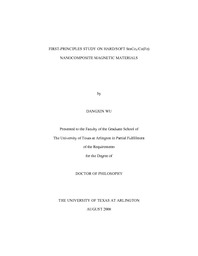
ATTENTION: The works hosted here are being migrated to a new repository that will consolidate resources, improve discoverability, and better show UTA's research impact on the global community. We will update authors as the migration progresses. Please see MavMatrix for more information.
Show simple item record
| dc.contributor.author | Wu, Dangxin | en_US |
| dc.date.accessioned | 2008-09-17T23:34:58Z | |
| dc.date.available | 2008-09-17T23:34:58Z | |
| dc.date.issued | 2008-09-17T23:34:58Z | |
| dc.date.submitted | July 2008 | en_US |
| dc.identifier.other | DISS-2147 | en_US |
| dc.identifier.uri | http://hdl.handle.net/10106/1042 | |
| dc.description.abstract | More than a decade ago, exchange-spring permanent magnets containing soft and hard magnetic phases have been proposed to enlarge maximum energy product values through exchange coupling between the magnetically soft and hard phases. Indeed some later experiments have shown some promises in this regard. However, there are still many pending fundamental issues in the understanding and enhancement of the exchange coupling. In this dissertation, we have performed first-principles study based on the density functional theory to tackle some of these issues, including the effects of soft phase properties and interfacial conditions on the exchange coupling, using SmCo5 as hard phase material and Co (CoFe) as soft phase material.
On the soft phase effects, we have investigated the structural, electronic and magnetic properties of FeCo alloys and found that the alloys are only stable in bcc-type structures and prefer chemically non-cubic geometries in a wide composition range. Due to this non-cubic preference, appreciable uniaxial magnetic anisotropy energies have been produced, which consequently facilitates the inter-phase magnetic interaction and enhances the overall magnetization in exchange-coupled nanocomposite systems.
On the interface effects, we have constructed a SmCo5/Co multilayer model system with optimized atomic structure. The non-collinear magnetic structures were calculated to explore the exchange coupling dependence on the variation of the atomic composition across the interface. It is found that the inter-phase exchange coupling is strongly dependent on the interfacial conditions between the hard and soft phases.
We have also investigated the possibility of FeCo nanowires as potential high performance permanent magnets considering their high shape anisotropy. We studied the electronic structure and magnetic properties of FeCo nanowires and calculated their magnetocrystalline anisotropy energies and shape anisotropy energies. | en_US |
| dc.description.sponsorship | Zhang, Qiming | en_US |
| dc.language.iso | EN | en_US |
| dc.publisher | Physics | en_US |
| dc.title | First-principles Study On Hard/soft SmCo5/Co(Fe) Nanocomposite Magnetic Materials | en_US |
| dc.type | Ph.D. | en_US |
| dc.contributor.committeeChair | Zhang, Qiming | en_US |
| dc.degree.department | Physics | en_US |
| dc.degree.discipline | Physics | en_US |
| dc.degree.grantor | University of Texas at Arlington | en_US |
| dc.degree.level | doctoral | en_US |
| dc.degree.name | Ph.D. | en_US |
| dc.identifier.externalLink | https://www.uta.edu/ra/real/editprofile.php?onlyview=1&pid=121 | |
| dc.identifier.externalLinkDescription | Link to Research Profiles | |
Files in this item
- Name:
- umi-uta-2147.pdf
- Size:
- 1.853Mb
- Format:
- PDF
This item appears in the following Collection(s)
Show simple item record


